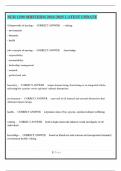Summary
Full Summary International Trade and Investment
- Course
- Institution
- Book
This summary contains the complete content of the course International Trade and Investment. It covers chapters 1 to 12 of Krugman, Obstfeld and Melitz, Chapter 17 of Appleyard and field and the Lecture Slides used by the professor. I am a summary writer for Athena and passed this course with an 8....
[Show more]













